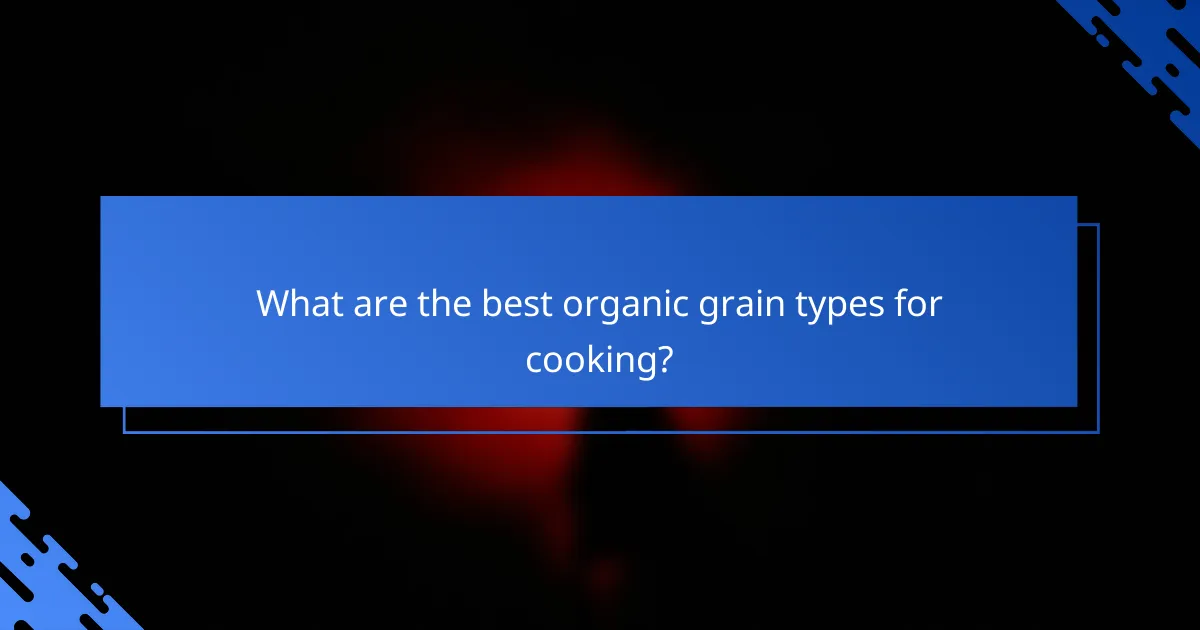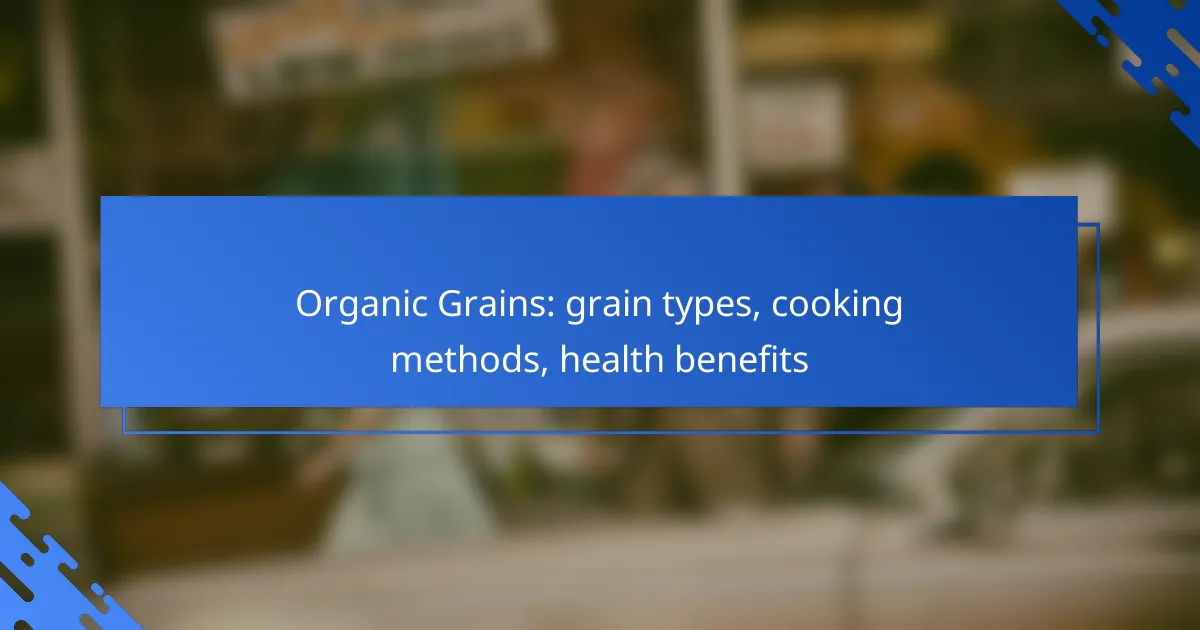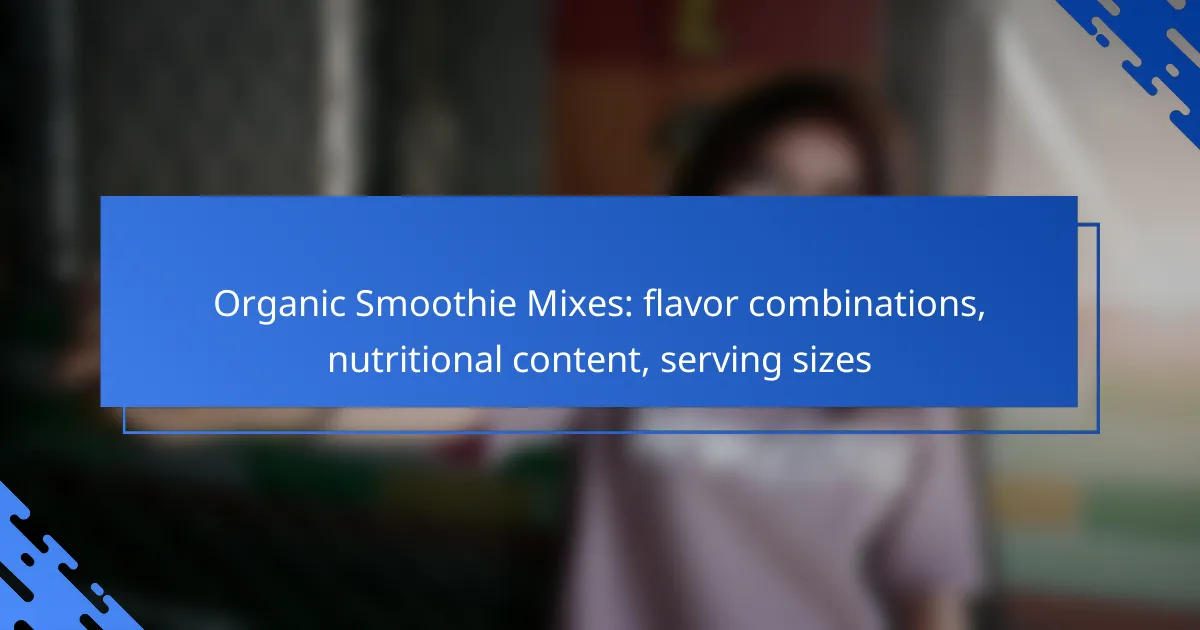Organic grains, such as quinoa, brown rice, farro, barley, and millet, provide a diverse array of flavors and textures, making them ideal for various culinary applications. Cooking methods like boiling, steaming, and slow cooking can enhance their nutritional value and taste. Rich in essential nutrients and free from synthetic additives, these grains contribute significantly to overall health and help lower the risk of chronic diseases.

What are the best organic grain types for cooking?
The best organic grain types for cooking include quinoa, brown rice, farro, barley, and millet. Each of these grains offers unique flavors, textures, and nutritional benefits, making them versatile options for various dishes.
Quinoa
Quinoa is a protein-rich grain that cooks quickly, typically in about 15 minutes. It has a slightly nutty flavor and a fluffy texture when prepared correctly. Rinse it before cooking to remove its natural coating, which can impart a bitter taste.
Use quinoa as a base for salads, bowls, or as a side dish. It pairs well with vegetables, beans, and herbs, making it a great addition to a variety of meals.
Brown rice
Brown rice is a whole grain that retains its bran and germ, providing more fiber and nutrients than white rice. Cooking brown rice usually takes around 40-50 minutes, so it’s best to plan ahead.
It works well as a side dish or in stir-fries, grain bowls, and soups. Soaking it for a few hours before cooking can reduce cooking time and improve texture.
Farro
Farro is an ancient grain with a chewy texture and nutty flavor. Cooking farro typically takes about 30-40 minutes, depending on the variety. It can be used in salads, soups, or as a hearty side dish.
Consider using farro in place of rice or pasta for a more nutritious option. Its robust flavor complements roasted vegetables and can be enhanced with herbs and spices.
Barley
Barley is a versatile grain that can be used in soups, stews, and salads. It has a chewy texture and a slightly sweet flavor. Cooking barley usually takes around 30-45 minutes, depending on whether you use hulled or pearl barley.
Hulled barley is more nutritious but takes longer to cook than pearl barley. Adding barley to your meals can increase fiber content and provide a satisfying, hearty element.
Millet
Millet is a small, gluten-free grain that cooks quickly, usually in about 20 minutes. It has a mild flavor and can be fluffy or creamy, depending on how it’s prepared. Rinse millet before cooking to enhance its flavor.
Millet can be used in porridge, as a side dish, or even in baking. It pairs well with both sweet and savory ingredients, making it a versatile addition to your pantry.

How to cook organic grains effectively?
Cooking organic grains effectively involves selecting the right method based on the type of grain and desired texture. Common methods include boiling, steaming, and using a slow cooker, each offering unique benefits and considerations.
Boiling method
The boiling method is straightforward and works well for most grains like rice, quinoa, and barley. Start by rinsing the grains to remove excess starch, then combine them with water in a pot, typically using a ratio of 1 part grain to 2 parts water.
Bring the water to a boil, then reduce the heat to a simmer and cover. Cooking times vary; for instance, quinoa takes about 15 minutes, while brown rice may require 40-50 minutes. Keep an eye on the water level to prevent burning.
Steaming method
Steaming is a gentle cooking method that helps retain nutrients in organic grains. Use a steamer basket over boiling water, ensuring the grains are not submerged. This method is particularly effective for grains like couscous and bulgur.
For steaming, the cooking time is generally shorter than boiling, usually around 10-20 minutes, depending on the grain. Check for doneness by tasting; the grains should be tender yet firm.
Slow cooker method
The slow cooker method is ideal for busy individuals as it requires minimal active cooking time. Combine rinsed grains with water in the slow cooker, typically using a 1:2 ratio, and set it on low for several hours.
This method works well for heartier grains like farro and steel-cut oats, which may take 4-6 hours. Ensure to check the water level occasionally, as slow cookers can vary in moisture retention. This method allows for easy meal prep and can be combined with vegetables and spices for added flavor.

What are the health benefits of organic grains?
Organic grains offer numerous health benefits, primarily due to their nutrient density and lack of synthetic additives. They are a great source of essential nutrients, promoting overall well-being and reducing the risk of chronic diseases.
High fiber content
Organic grains are typically high in dietary fiber, which aids in digestion and helps maintain a healthy weight. A diet rich in fiber can support regular bowel movements and prevent constipation.
Incorporating organic grains like oats, quinoa, and brown rice can significantly boost your daily fiber intake. Aim for at least 25-30 grams of fiber per day for optimal health benefits.
Rich in vitamins and minerals
Organic grains are packed with essential vitamins and minerals, including B vitamins, iron, magnesium, and zinc. These nutrients play crucial roles in energy production, immune function, and overall health.
For example, quinoa is a complete protein and contains significant amounts of magnesium, while whole wheat provides B vitamins that support metabolism. Choosing a variety of organic grains can help ensure a well-rounded nutrient profile.
Supports heart health
Consuming organic grains can contribute to better heart health by lowering cholesterol levels and reducing blood pressure. Whole grains are known to contain antioxidants and anti-inflammatory properties that benefit cardiovascular health.
Incorporating grains like barley and farro into your meals can be beneficial. Aim to replace refined grains with whole, organic options to maximize heart health benefits.

How do organic grains compare to conventional grains?
Organic grains generally offer higher quality and safety than conventional grains. They are produced without synthetic fertilizers and pesticides, which can lead to differences in nutrient content and chemical residues.
Higher nutrient density
Organic grains tend to have a higher nutrient density compared to their conventional counterparts. This means they often contain more vitamins, minerals, and antioxidants, which are essential for overall health. Studies suggest that organic grains may provide better levels of certain nutrients, such as magnesium and iron.
When selecting grains, consider options like quinoa, brown rice, and whole wheat, which are commonly available in organic forms. These grains not only enhance your diet but also support sustainable farming practices.
Lower pesticide residues
One of the significant advantages of organic grains is their lower pesticide residues. Organic farming practices prohibit the use of synthetic pesticides, resulting in grains that are less likely to contain harmful chemicals. This is particularly important for consumers concerned about food safety and health.
Choosing organic grains can reduce your exposure to pesticide residues, which may be beneficial for long-term health. Look for certification labels, such as USDA Organic, to ensure that the grains you purchase meet organic standards.

What are the best cooking tools for organic grains?
The best cooking tools for organic grains include specialized appliances that simplify the cooking process and enhance flavor. Key options are rice cookers and Instant Pots, each offering unique features that cater to different cooking styles and preferences.
Rice cooker
A rice cooker is designed specifically for cooking rice and other grains, providing consistent results with minimal effort. It typically features a simple one-button operation and automatically switches to a keep-warm setting once the cooking cycle is complete.
When using a rice cooker, it’s important to measure the water-to-grain ratio accurately, usually around 1.5 to 2 cups of water for every cup of organic grains. Avoid overfilling the cooker to prevent spillage and ensure even cooking.
Instant Pot
The Instant Pot is a versatile multi-cooker that can prepare grains quickly under pressure, making it a great choice for busy cooks. It can also sauté, steam, and slow-cook, providing flexibility for various recipes.
For cooking organic grains in an Instant Pot, use a water-to-grain ratio of about 1:1 for most grains, but be sure to adjust based on the specific type of grain. Cooking times can vary, typically ranging from 10 to 20 minutes, depending on the grain and desired texture.










